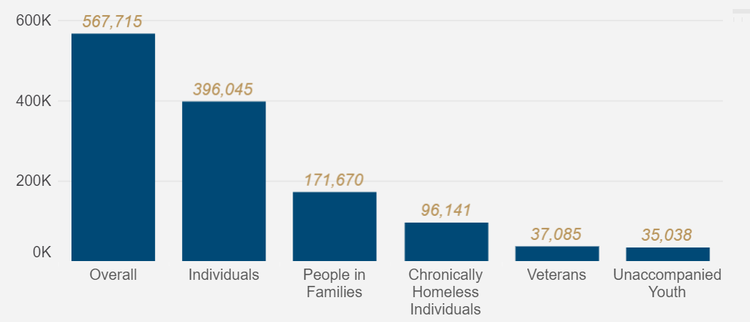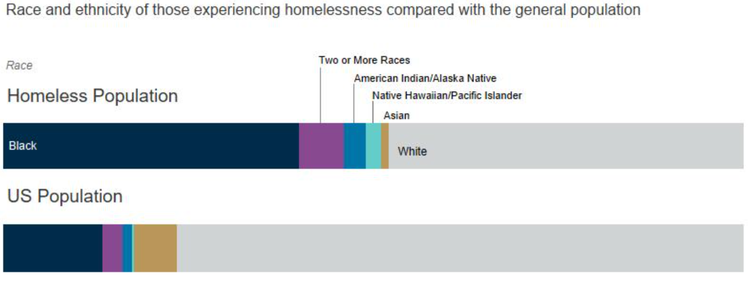
Every night, thousands of Americans, from all age groups and ethnic backgrounds, sleep without the safety, stability and support of family or a home.
In the most recent number reported by the U.S. department of Housing and Urban Development (HUD), 17 out of every 1,000 people in the U.S. are experiencing homelessness at any given day, and since the beginning of 2020, COVID-19 has further exacerbated the issue and increased the risk for the vulnerable homeless population. Furthermore, although we are seeing more and more local & state governments and non-profit organizations introducing new programs and resources to tackle this issue in their respective jurisdictions, it often requires a regional effort that transcends the City and County lines.
In this article, we will take a closer look at the issue of homelessness and ways for local governments to introduce measures to tackle this problem.
Be sure to check out our Education section to learn more about municipal bonds.
Understanding Homelessness
Often viewed as the coastal issue in the U.S., homelessness exists in every small to large city in the United States; however, due to the lack of affordable housing and sky-high rents, we often see a large homeless population in cities like San Francisco, Seattle, New York City and Portland. The Department of Housing and Urban Development (HUD) defines homelessness as:
- Individuals or a family who lacks a fixed, regular and adequate nighttime residence;
- Individuals who live in their cars, bus shelters or a campground;
- And, if they are in a shelter of transitional housing.

Although the issue of homelessness isn’t simple and clear cut, it’s often divided into two main segments:
- Short-term homelessness, and
- Chronic homelessness.
As the name suggests, short-term homelessness is often caused by things like job loss, family break-ups and/or domestic violence, etc., and with adequate short-term housing and support, these individuals can find employment and integrate back into society. On the other hand, chronic homelessness occurs when an individual has been without adequate housing for over a year and has some barrier to finding employment or housing, such as substance abuse, disability, mental health crisis, etc.
Furthermore, most minority groups in the United States, including African Americans and the Indigenous population, face homelessness at much higher rates. As the data by National Alliance to End Homelessness indicates, African Americans make up 13 percent of the U.S. population but make up over 40 percent of the homeless population. The predominant reason for these racial disparities can be attributed to the socioeconomic conditions of minority population, rental housing discriminations, incarcerations and access to equitable healthcare.

Click here to learn more about the municipal debt due diligence process.
The Need of a Collaborative Action by Local and State Governments
When addressing the issue of homelessness, local and state policymakers often differ on their approaches:
- Whether they need to first tackle the issue by building/finding affordable housing for the homeless population (Housing-First approach) and then connect them with other services like access to healthcare and finding training and employment opportunities;
- Or, if they need to first help the homeless population with things like drug rehabilitation, mental health treatment, etc., before housing them.
Throughout the United States, both approaches are widely used; however, the data and experts argue that an adequate housing (under the Housing-First strategy) for the homeless population, before other services, will be the most important step for a homeless individual. The National Alliance to End Homelessness proposes few critical & proven steps for local and state governments to collaboratively tackle the issue of homelessness:
- 1. Creating a Coordinated System That Works for Each Jurisdiction: This is the first and one of the most critical steps in addressing, collecting data, planning and measuring effectiveness of a local homelessness strategy. A collaborative collection of data through various channels, but into a single system, can help various communities set goals and conceptualize what they should prioritize and set appropriate goals and timelines to address the issue. Furthermore, A Homeless Management Information System (HMIS), introduced by the U.S. Department of Housing and Urban Development (HUD), can be an important local information technology system to collect client, program and system-level data on the provisions of housing and services to homeless individuals and families, and persons at risk of homelessness.
- 2. Rapid Re-Housing Efforts: The aforementioned Housing First strategy to address homelessness goes hand in hand with the Rapid Re-Housing (RRH) efforts for local governments. It’s also important that a permanent housing address will not only help address getting people into affordable housing, but also help to integrate them into society with the assistance of finding suitable employment. The National Alliance to End Homelessness describes the Rapid Re-Housing strategy as the critical step that “provides short-term rental assistance and services.” The goals are to help people obtain housing quickly, increase self- sufficiency and stay housed. It is offered without preconditions (such as employment, income, absence of criminal record or sobriety), and the resources and services provided are typically tailored to the needs of the person.”
- 3. Assistance for the Most Vulnerable to Address Chronic Homelessness: Aside from transitional housing typically needed on a short-term basis, the chronically homeless population is the most vulnerable and often need permanent supportive housing. Per the Housing and Urban Development data, an adequate “investments in permanent supportive housing have helped decrease the number of chronically homeless individuals by 20 percent since 2007.” These services also often lead to increase in housing stability, improve health and seek additional resources provided by the local and state government for individuals that are most vulnerable. In addition, this strategy takes the strain off of other service providers when this population is adequately housed like local hospitals, shelters and even law enforcement resources.
- 4. Introducing Employment and Income Opportunities: Besides the affordable housing and other critical services, the need to reintegrate the homeless population means introducing/creating employment opportunities that will lead to financial independence and housing stability in the future. With the increase in homelessness over the years, the short-term housing options are meant to be a transitional support system, until the individuals are able to get back on their feet. Many of the efforts and programs introduced by non-profit organizations and even local governments entail an integrative path back to normalcy and the critical step in that path is finding employment, the ability to pay rent and also to stabilize their income. However, this can take some time and additional resources from local and state governments to provide the training and resources for this vulnerable population to get on track of their progress and the effectiveness of their efforts.
The Workforce Innovation and Opportunity Act introduced by the Department of Labor (DOL) is an example of efforts to “strengthen and improve our nation’s public workforce system and help get Americans, including youth and those with significant barriers to employment, into high-quality jobs and careers and help employers hire and retain skilled workers.”
The Bottom Line
For decades, increasing rents and home affordability have been the key drivers for homelessness. However, in the recent years this issue has become more bi-partisan at all levels of government and political leaders are recognizing the compounded impacts of homelessness on other local resources. The local and state government should consider a regional collaborative approach to address the issue that’s both equitable and driven by data.
Sign up for our free newsletter to get the latest news on municipal bonds delivered to your inbox.
Disclaimer: The opinions and statements expressed in this article are for informational purposes only and are not intended to provide investment advice or guidance in any way and do not represent a solicitation to buy, sell or hold any of the securities mentioned. Opinions and statements expressed reflect only the view or judgement of the author(s) at the time of publication and are subject to change without notice. Information has been derived from sources deemed to be reliable, the reliability of which is not guaranteed. Readers are encouraged to obtain official statements and other disclosure documents on their own and/or to consult with their own investment professionals and advisers prior to making any investment decisions.






